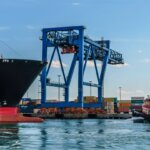ConTech: full lifecycle solutions build better supply chains

There are many ways to improve supply chains. Quantum computers can be deployed to find the most efficient transport route. Circuit design tools fed with component stock-level data can be used to reduce wait times for electronic products. Scraping the web for global news can alert companies to upcoming incidents and extend contingency planning windows. But sometimes, the best way to improve supply chains is to build new roads, upgrade railways, and construct larger port facilities – to give just a few examples of infrastructure that’s essential in transporting goods from A to B. And managing those huge projects becomes a whole lot easier and more insightful when you have full lifecycle construction technology (ConTech) solutions at your fingertips.
Seasonal forecast
To put you in the picture, imagine being able to use analytical tools trained on a wealth of construction project data to answer questions about your own project. Let’s say you’re wondering about the cost implications of bringing a project forward to February or delaying construction until August. ConTech solutions can provide an accurate forecast based on billions of dollars-worth of planning, construction, and operations insight. Modern cloud-based, software is transforming the way that infrastructure projects get off the ground and can bring numerous efficiency savings from start to finish.
For example, Utah’s Department of Transport, which develops and maintains a network of 243 highways across the state and manages $25 billion of capital projects and investments, expects to save around $100 million using capital planning and construction project management software. New features in ConTech solutions integrate machine learning capabilities such as sentiment analysis. Social media feeds can be analyzed to gauge public opinion; helping city planners to determine which infrastructure deficiencies should be prioritized. “It’s important to arrive at a plan that makes sense to stakeholders,” Balaji Sreenivasan – founder and CEO of Aurigo Software Technologies, a provider of ConTech solutions – told TechHQ.
City planners can use capital planning tools to manage the process of turning a budget into a list of projects that they can be confident will address the major deficiencies affecting businesses and residents. And, as Sreenivasan points out, the importance of getting that initial deficiency assessment right cannot be overstated. The construction phase that follows rests on those initial requirements, and any deficiencies could percolate throughout the whole lifecycle.
Improving supply chains
Multi-billion dollar, multi-year infrastructure programs – to improve supply chains and other city services – are a big investment in time and money; picking the right project is critical. What-if scenario planning adds a layer of reassurance, bringing project future-proofing to the table. And organizing the whole process through a single, specialist ConTech application, rather than making do with separate, general software tools can save works departments months.
Estimation and bidding comes next, where having the capacity to refine ballpark figures and build on historical data gives project teams a much richer picture of likely infrastructure costs. Inflation curve adjustments can be made to make sure that the construction phase is funded sufficiently when the go-ahead is given. “It’s important to take into account the timeline for getting projects approved and to determine what the costs will be then,” said Sreenivasan.
Aurigo started in 2003 as a ConTech company that helped digitize buildings inspection, eliminating paperwork and taking a data-led approach to the construction sector. Today, the firm offers all-in-one portfolio planning and construction management software that’s being used to manage hundreds of billions of dollars of construction data. The expansion from a point solution to full lifecycle support highlights the scale of digital transformation taking place across the construction industry. Smartphones, tablets, and mobile apps have made it much easier to bring digital solutions on site. Other devices are having a positive impact too.
Health and safety developments
On TechHQ we’ve written about how aerial robotics has transformed warehouse inventory monitoring. Drones in supply chain management can conduct inventory counts in hours as opposed to days, if operations are performed manually. Digitization dramatically speeds up the process, and there are other benefits, such as improvements in safety. Examining pallets high up in warehouses can be dangerous for employees, but drones can safely scan items in seconds.
Aurigo is partnering with the University of Florida to develop underwater inspection drones capable of carrying out multiple measurements automatically, uploading their data to the cloud – where findings can integrate with ConTech software. Sreenivasan is proud of the project. Drone technology could make a big difference in reducing accidents as underwater inspection carries health and safety risks for workers.
Dubbed the ‘Bathy-Drone’, the system comprises a semi-submersible sonar rig that can be towed using a remotely controlled drone. The absence of any propellors reduces the chances of the towed sensors becoming snagged on floating vegetation. And the unit can easily be dragged over sandbars if needed. In a recent paper, University of Florida researchers report that an autonomous uncrewed drone-tethered sonar system can survey an area of more than 10 acres in less than 25 mins and on one battery charge.
Sreenivasan adds that there are opportunities to gather water samples automatically too. Adding to the range of services that can be carried out using drone technology. Taking an arial view, ConTech is streamlining a broad range of project planning and management services, helping to build better supply chains and other infrastructure. And at the same time, zooming in, innovative hardware – such as drones and other devices – is changing the way that key steps in the process are being performed – making construction safer for workers.










